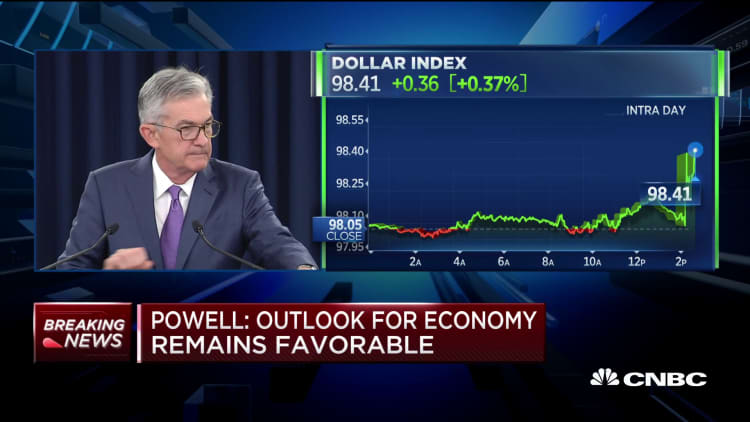
Stocks cratered, the dollar hit a more than two-year high and bond yields ripped higher after Fed Chairman Jerome Powell suggested that policymakers were not embarking on a new cycle of rate cutting, after it trimmed the fed funds rate by a quarter point Wednesday.
Markets have been on tenterhooks, once expecting three rate hikes this year, and then an easy Fed policy stance, even as the economy has been showing signs of improvement. But the Fed has been facing the unusual task of explaining why it was cutting rates in the face of stronger economic data.
Traders said there was disappointment with the Fed's statement, which was perceived more as neutral than dovish, but when Powell later said during a press briefing that the Fed's action was a "midcycle adjustment to policy" that sent markets reeling.
"I think by that it means he doesn't necessarily mean more cuts are coming, maybe not necessarily one off but not indicative of more aggressive cuts," said Ben Jeffery, a fixed income strategist at BMO.

Powell later explained, during his press conference, that he meant that the Fed was not embarking on a long rate-cutting cycle, as in a recession. He also described a Fed policy transition that began after it raised rates for the last time in December, then paused and then moved forward to cut rates by a quarter point. The fed funds rate range is now 2 to 2.25%.
"Let me be clear: What I said was it's not the beginning of a long series of rate cuts," Powell said. "I didn't say it's just one or anything like that. When you think about rate-cutting cycles, they go on for a long time and the committee's not seeing that. Not seeing us in that place. You would do that if you saw real economic weakness and you thought that the federal funds rate needed to be cut a lot. That's not what we're seeing."
Ward McCarthy, Jefferies chief financial economist, said Powell did not make a strong case for the cut where he described once "boiling" trade issues as now "simmering." The cut was also met by two dissenters, from Boston Fed President Eric Rosengren and Kansas City Fed President Esther George.
"The position is not well enunciated. The policy statement was ambiguous and frankly he hasn't done anything to clarify it," McCarthy said. "He seems like he's not confident. My take is they're worried about downside risks. Since they've already taken the step [to cut rates], they'll probably take another, but his comments and the two dissents suggest this is not the beginning of a major easing cycle and that's what hammered the market."
BMO's Jeffery said fed funds futures are now reflecting slower rate cutting by the Fed. In the fed funds futures, there is a 60% chance of a 25 basis cut for September, but a 100% chance of the next quarter point by November.
"I don't think it accomplished anything," McCarthy said. "It may temporarily satiate market expectations, but the price action suggested the opposite, and you know it's not going to satiate the White House twitter account. I think the Fed has put itself in a very awkward position. It could not easily defend itself, and that's what we're getting out of Powell."
President Donald Trump tweeted later in the day that he was disappointed with the rate cut and Powell "let us down," but added that at least the Fed ended its quantitative tightening program.
The reaction from the bond market was one of confusion, and strategists were looking for Fed officials to clarify the message in coming days.
"It was a very confusing and muddled message, and I don't think that Powell delivered clear direction for what the near term path of additional Fed easing will be, and I think that's why the market reacted negatively," said Mark Cabana, head of U.S. short rate strategy at Bank of America Merrill Lynch.
The Dow fell as much as 478 points and ended down 333 points in its worst day since May. The 2-year Treasury yield, most reflecting the Fed 's policy, went on a wild ride to above 1.95% from a low of 1.79% before the Fed statement.


